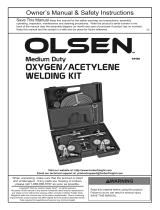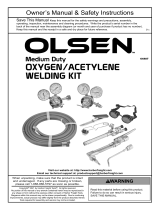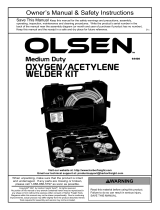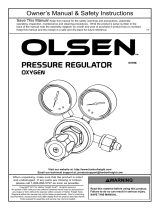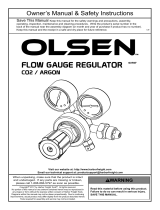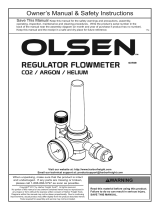
Visit our website at: http://www.harborfreight.com
Email our technical support at: [email protected]
Owner’s Manual & Safety Instructions
Save This Manual Keep this manual for the safety warnings and precautions, assembly,
operating, inspection, maintenance and cleaning procedures. Write the product’s serial number in the
back of the manual near the assembly diagram (or month and year of purchase if product has no number).
Keep this manual and the receipt in a safe and dry place for future reference. 20g
When unpacking, make sure that the product is intact
and undamaged. If any parts are missing or broken,
please call 1-888-866-5797 as soon as possible.
Copyright
©
2020 by Harbor Freight Tools
®
. All rights reserved.
No portion of this manual or any artwork contained herein may be reproduced in
any shape or form without the express written consent of Harbor Freight Tools.
Diagrams within this manual may not be drawn proportionally. Due to continuing
improvements, actual product may differ slightly from the product described herein.
Tools required for assembly an d se rv ic e may n ot b e in cl uded.
Read this material before using this product.
Failure to do so can result in serious injury.
SAVE THIS MANUAL.

Page 2 For technical questions, please call 1-888-866-5797. Item 57574
WARNING SYMBOLS AND DEFINITIONS
This is the safety alert symbol. It is used to alert you to potential personal injury hazards.
Obey all safety messages that follow this symbol to avoid possible injury or death.
Indicates a hazardous situation which, if not avoided,
will result in death or serious injury.
Indicates a hazardous situation which, if not avoided,
could result in death or serious injury.
Indicates a hazardous situation which, if not avoided,
could result in minor or moderate injury.
Addresses practices not related to personal injury.
IMPORTANT SAFETY INSTRUCTIONS
Read all safety warnings and instructions.
Failure to follow the warnings and instructions may result in electric shock, fire and/or serious injury.
Save all warnings and instructions for future reference.
The warnings, precautions, and instructions discussed in this instruction manual
cannot cover all possible conditions and situations that may occur.
It must be understood by the operator that common sense and caution are factors which
cannot be built into this product, but must be supplied by the operator.
Work Area Safety
1. Keep your work area clean and well lit.
Cluttered benches and dark areas invite accidents.
2. Keep bystanders, children, and visitors away
while operating. Distractions can cause you to
lose control. Protect others in the work area from
intense heat. Do not allow others close enough to
look at the flame as eye damage is a real possibility.
Provide barriers or shields as needed.
3. When possible, move the work to a location well
away from combustible materials. If relocation
is NOT possible, protect the combustibles with a
cover made of fire resistant material. Remove or
make safe all combustible materials for a radius
of 35 feet (10 meters) around the work area.
4. Enclose the work area with portable fire
resistant screens. Use a fire resistant
material to block all openings and protect
combustible walls, ceilings, floors, etc.
5. If working near/on a metal wall, ceiling, floor, etc.,
prevent ignition of combustibles on the other side
by moving the combustibles to a safe location.
If relocation of combustibles is NOT possible,
designate someone to act as a fire watch equipped
with a fire extinguisher during the welding or
cutting process and for at least one half hour after
the welding or cutting project is completed.
6. Do not place the Regulator on any material other
than bare concrete until it has cooled completely.
7. Do not weld or cut any material that has a
combustible coating or a combustible internal
structure, such as drums or tanks, without an
approved method for eliminating the hazard.
8. Do not dispose of hot slag in containers
holding combustible materials.
9. Keep a fully charged fire extinguisher close
by and know the proper way to use it.
10. After welding or cutting make a thorough
check for evidence of fire and be aware the
easily visible flame or smoke may not be
present for some time after a fire has started.

Page 3For technical questions, please call 1-888-866-5797.Item 57574
11. Do not weld or cut in atmospheres
containing dangerously reactive or
flammable gases, vapors, liquids, or dust.
12. Clean and purge containers before applying heat.
Do not apply heat to a container that has held an
unknown substance or a combustible material whose
contents, when heated, can produce flammable or
explosive vapors. Vent closed containers, including
castings, before preheating, cutting, or welding.
Personal Safety
1. Wearing and using personal safety clothing and
safety devices reduce the risk of injury.
Wear the following:
a. Fire-resistant clothing (Do not wear pants with
cuffs, shirts with open pockets, or any clothing
that can catch and hold molten metal or sparks.)
b. Fire-resistant leather leggings and work boots
c. Dry, insulating leather welding gloves
d. NIOSH-approved respirator
e. Shade 5 or higher welding goggles
f. Appropriate head covering to
protect head and neck
g. Fire-resistant ear plugs or ear muffs (if welding
or cutting overhead or in confined spaces)
Keep clothing and safety equipment free of grease,
oil, solvents and any other flammable substances.
2. Stay alert. Watch what you are doing, and
use common sense when operating this
Regulator.
Do not use while tired or under the
influence of drugs, alcohol, or medication.
A moment of inattention while operating
may result in serious personal injury.
3. Do not overreach. Keep proper footing and
balance at all times. Proper footing and balance
enables better control in unexpected situations.
4. INHALATION HAZARD:
Welding and Cutting Produce
TOXIC FUMES.
Exposure to welding or cutting exhaust fumes can
increase the risk of developing certain cancers,
such as cancer of the larynx and lung cancer.
Also, some diseases that may be linked to exposure
to welding or cutting exhaust fumes are:
• Early onset of Parkinson’s Disease
• Heart disease • Ulcers
• Damage to the reproductive organs
• Inflammation of the small intestine or stomach
• Kidney damage
• Respiratory diseases such as
emphysema, bronchitis, or pneumonia
Use natural or forced air ventilation and
wear a respirator approved by NIOSH to
protect against the fumes produced to
reduce the risk of developing the
above illnesses.
5. Avoid overexposure to fumes and gases. Keep
your head out of the fumes. Do not breathe fumes.
Use enough ventilation or exhaust, or both to keep
fumes and gases away from your breathing area.
Where ventilation is questionable, have a qualified
technician take an air sampling to determine the
need for corrective measures. If necessary, use
mechanical ventilation to improve air quality. If this
is not possible, use an approved respirator. Do not
work in confined areas unless they are well-ventilated
or you are wearing an air supplied ventilator.
Always follow OSHA guidelines for Permissible
Exposure Limits (PEL’s) for various fumes and gases.
Follow the American Conference of Governmental
Industrial Hygienists recommendations for the
Threshold Limit Values (TLV’s) for fumes and
gases. Have a recognized specialist in Industrial
Hygiene or Environmental Services check the
operation and air quality and make recommendations
for the specific welding or cutting situation.

Page 4 For technical questions, please call 1-888-866-5797. Item 57574
Equipment Setup Safety
1. Make sure you are prepared to begin
work before opening gas supply.
2. To prevent explosion, use reverse-flow
check valves and flashback arrestors
(sold separately) on the base of the Regulator.
3. Use with oxygen and acetylene only. Do
not modify this Regulator or use it for a
purpose for which it is not intended.
4. Set Acetylene Regulator no greater than 15 PSI.
Acetylene is unstable and can
explode if over-pressurized.
5. Do not use oil, grease or thread seal tape
on any connector.
6. Use clamps (not included) or other practical
ways to secure and support the workpiece
to a stable platform. Holding the work by hand
or against your body is unstable and may lead
to loss of control, fire and/or personal injury.
7. Use only accessories that are recommended
by the manufacturer for your model Regulator.
Accessories that may be suitable for one Regulator
may become hazardous when used on
another Regulator.
Only use proper gas hoses.
Cylinder Safety
1. Do not use dented or damaged cylinders.
2. Secure cylinders to a cart, wall, or post to prevent
them from falling.
Use and store cylinders in an upright position only.
3. Use cylinder caps when moving
or storing cylinders.
4. Do not store cylinders in
temperatures 120° F or higher.
5. EMPTY CYLINDERS:
DO NOT DROP, STRIKE, PUNCTURE, HEAT OR
SET FIRE TO A CYLINDER, EVEN IF IT IS EMPTY.
Keep empty cylinders in specified areas
and clearly mark “empty.” Contact local
solid waste authorities for instructions on correct
disposal or recycling of empty cylinders.
6. KEEP WRENCH ON
ACETYLENE CYLINDER’S VALVE
whenever cylinder is in use to allow
quick shutoff in case of emergency.
Equipment Inspection
1. DO NOT USE FLAME TO DETECT LEAKS.
2. INSPECT BEFORE EVERY USE.
Look for the following, and do not
use kit if any damage is noted:
a. Inspect the tapered seating surfaces on the
Nozzles and the Tip Nut. Have a qualified
technician resurface the seat area if it has
dents, burrs, or is burned. A poor seating
surface may result in backfire or flashback.
b. Examine all hoses for cuts, cracks,
burns, worn areas, or other damage.
Do not use if damaged.
c. Check for loose connections using soapy
water solution. Tighten or repair any leaks found.
d. Do not use the Regulator if either gas
does not turn off completely when
the Oxygen Regulator Valve and
Acetylene Regulator Valve are closed. Leakage
of gas from the tip is a substantial safety risk.
If gas cannot be turned off at the Regulator
Handle, it is dangerous and must be replaced.
e. Inspect for any other defects or damage.
Do not use any damaged parts.
Tag damaged parts “Do not use” until repaired.
Operation Safety
1. Inspect before every use;
see previous warning section.
2. Use only with proper ventilation.
3. Do not touch workpiece or tip until cool.
4. Keep hoses away from hot parts, from
weld/cut area, and from flame.
5. Never leave the Regulator unattended
when it is attached to a gas supply.
6. Allow sufficient time for the Regulator
to completely cool before storing.
7. Any material discharged from the work area
during use will be extremely hot. Use care to
not get burned by slag or other waste products.

Page 5For technical questions, please call 1-888-866-5797.Item 57574
8. BACKFIRE:
When the flame goes out with a loud “pop,” it is
called a backfire. Backfire can be caused by:
a. Operating the Regulator at lower pressures
than required for the Tip used.
b. Touching the Tip against the workpiece.
c. Overheating the Tip.
d. An obstruction in the Tip.
If backfire occurs, close the Torch Handle Valves
(oxygen first, then acetylene) and after
remedying the cause, relight the Regulator.
9. FLASHBACK:
Flashback is a condition that results when the flame
flashes back into the Regulator and burns inside with
a shrill hissing or squealing noise.
If flashback occurs, close the Torch Handle Valves
(oxygen first, then acetylene) IMMEDIATELY!
Flashback generally indicates a problem that should
be repaired before proceeding with the job at hand.
A clogged Tip, improper functioning of the Valves,
or incorrect acetylene/oxygen pressure could lead
to flashback. Find and correct the cause before
relighting the Regulator.
If the cause is not found, have the kit serviced by a
qualified technician before returning to your project.
10. Beware of leaking gas.
If you notice the odor of acetylene during use,
close the Torch Handle Valves
(oxygen first, then acetylene) IMMEDIATELY!
Extinguish all open flames and carefully check all
hoses and connections for leaks using soapy water.
NEVER check for leaks using a flame.
If the odor continues do not use the Regulator.
Call acetylene supplier for assistance.
11. Read and understand all instructions and safety
precautions as outlined in the manufacturer’s
manual for the material you will weld or cut.
12. After use, bleed lines and store all
components out of reach of children and
other untrained persons. Regulators are
dangerous in the hands of untrained users.
Service
1. Regulator service must be performed only by
qualified repair personnel.
Service or maintenance performed by unqualified
personnel could result in a risk of injury.
2. When servicing, use only identical replacement
parts. Follow instructions in the
“Maintenance Instructions” section of
this manual. Use of unauthorized parts or
failure to follow maintenance instructions
may create a risk of fire or injury.
3. Maintain product labels and nameplates. These
carry important information. If unreadable or missing,
contact Harbor Freight Tools for a replacement.
SAVE THESE INSTRUCTIONS.
Symbology
CGA
Compressed Gas Association
ft
3
Cubic Feet
PSI
Pounds per Square Inch
CFH
Cubic Feet per Hour flow
OXY
Oxygen related components
GAS
Fuel gas (acetylene)
related components
WARNING marking concerning Risk
of Eye Injury. Wear ANSI-approved
safety goggles with side shields.
Read the manual before
set-up and/or use.
WARNING marking concerning
Risk of Explosion.
Do not use flame to detect leaks.
Handle cylinders properly.
WARNING marking concerning
Risk of Inhalation Hazard.
Use in well-ventilated area only.

Page 6 For technical questions, please call 1-888-866-5797. Item 57574
Specifications
Connection CGA 510
Setup
Read the ENTIRE IMPORTANT SAFETY INFORMATION section at the beginning of this
manual including all text under subheadings therein before set up or use of this product.
Workpiece and Work Area Setup
1. Designate a work area that is clean and well-lit.
The work area must not allow access by children
or pets to prevent distraction and injury.
2. Remove all combustible material from area and/
or cover surfaces with fire resistant material.
3. The work area must have a fireproof floor.
4. Secure loose workpieces using a vise or clamps
(not included) to prevent movement while working.
Note: Proper weld preparation can be complicated,
and is outside the scope of this manual.
Tool Set Up
Read the ENTIRE IMPORTANT SAFETY INFORMATION section at the beginning of this
manual including all text under subheadings therein before set up or use of this product.
TO PREVENT SERIOUS INJURY FROM EXPLOSION:
Turn the Oxygen and Acetylene Regulator Valves fully clockwise to close
(oxygen first and acetylene second) before making any adjustments or
performing any inspection or service to this product.
1. Secure cylinders to a cart, wall, or post to
prevent them from falling. Do not place
Acetylene Cylinder on its side.
WARNING! TO PREVENT FIRE AND EXPLOSION:
Make sure there is no oil, grease, or ignition source
(such as a hot weld, electric motor, or
another welding operation) nearby before
proceeding with the next step.
2. While standing to one side, “crack” cylinder valve.
“Cracking” is to quickly open and close the valve,
allowing a small amount of gas to escape and
clearing the valve of any foreign material.
WARNING! If oil or grease is found,
discontinue using cylinder and
immediately contact your gas supplier.
Briefly open valve to clean,
then close valve.
Figure A: Crack Each Cylinder Valve
3. Attach the Red labeled Acetylene Regulator to the
Acetylene Cylinder, tighten counterclockwise
- threads are reversed.
No Leaks Found
If the leak testing has been completed and the unit is
found to be working properly, open the cylinder valve,
turning counterclockwise, and proceed to operation.
WARNING! Only open Acetylene Cylinder Valve
1/4 to 1/2 turn to allow quick shutoff.
Acetylene
Cylinder
Figure B: Open Cylinder Valve Only
After Testing Confirms There Are No Leaks

Page 7For technical questions, please call 1-888-866-5797.Item 57574
Maintenance Instructions
Procedures not specifically explained in this manual must
be performed only by a qualified technician.
TO PREVENT SERIOUS INJURY AND DEATH FROM FIRE OR EXPLOSION:
Close the oxygen cylinder valve, then acetylene cylinder valve
and allow the Regulator to cool completely, then disconnect the hoses
before performing any inspection, maintenance, or cleaning procedures.
Do not use damaged equipment. If abnormal noise, vibration, or
leaking gas occurs, have the problem corrected before further use.
1. BEFORE EACH USE, inspect the general condition
of the Regulator. Check for loose hose connections,
cracked or worn hoses, and any other condition that
may affect its safe operation.
If any abnormal condition occurs or is noticed,
have the problem corrected before further use.
Do not use damaged equipment.
2. To clean the outer body of the Regulator, use a
clean, dry, cloth. Do not immerse any part of the
Regulator in ANY liquid. Do not use solvents or
other flammable agents to clean the Regulator.
Troubleshooting
Problem Possible Causes Likely Solutions
Before turning on
Regulator, gas
odor is noticed.
1. Hose connections loose.
2. Crack in hose.
3. Cylinder leak at neck.
1. Tighten all connections.
2. Check hoses. If any cracks are found, replace entire hose.
DO NOT PATCH OR TAPE GAS HOSES.
3. Check neck area of cylinders.
If cracks or damage are found, do not use.
Secure upright, in a well-ventilated area, well away from
sources of ignition. Contact gas supplier IMMEDIATELY.
Replace cylinders before proceeding with work.
Flame is irregular. 1. Tip clogged or dirty.
2. Gas low.
1. Close gas, acetylene first, then oxygen.
Let Regulator cool completely.
Remove Tip, check for dirt and debris.
Use tip cleaner to clean Tip or replace if necessary.
2. Check gas level and refill if needed.
Follow all safety precautions whenever diagnosing or servicing the tool.
Disconnect air supply before service.
Record Product’s Serial Number Here:
Note: If product has no serial number, record
month and year of purchase instead.
Note: Replacement parts are not available for
this item. Reference UPC 193175417565

Limited 90 Day Warranty
Harbor Freight Tools Co. makes every effort to assure that its products meet high quality and durability standards,
and warrants to the original purchaser that this product is free from defects in materials and workmanship for the
period of 90 days from the date of purchase. This warranty does not apply to damage due directly or indirectly,
to misuse, abuse, negligence or accidents, repairs or alterations outside our facilities, criminal activity, improper
installation, normal wear and tear, or to lack of maintenance. We shall in no event be liable for death, injuries
to persons or property, or for incidental, contingent, special or consequential damages arising from the use of
our product. Some states do not allow the exclusion or limitation of incidental or consequential damages, so the
above limitation of exclusion may not apply to you. THIS WARRANTY IS EXPRESSLY IN LIEU OF ALL OTHER
WARRANTIES, EXPRESS OR IMPLIED, INCLUDING THE WARRANTIES OF MERCHANTABILITY AND FITNESS.
To take advantage of this warranty, the product or part must be returned to us with transportation charges
prepaid. Proof of purchase date and an explanation of the complaint must accompany the merchandise.
If our inspection verifies the defect, we will either repair or replace the product at our election or we may
elect to refund the purchase price if we cannot readily and quickly provide you with a replacement. We will
return repaired products at our expense, but if we determine there is no defect, or that the defect resulted
from causes not within the scope of our warranty, then you must bear the cost of returning the product.
This warranty gives you specific legal rights and you may also have other rights which vary from state to state.
26541 Agoura Road • Calabasas, CA 91302 • 1-888-866-5797
/
